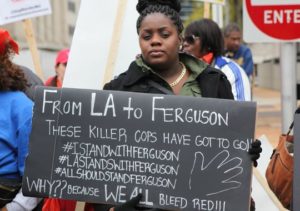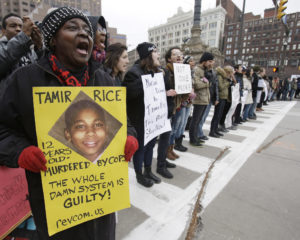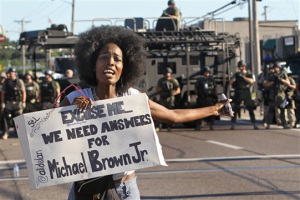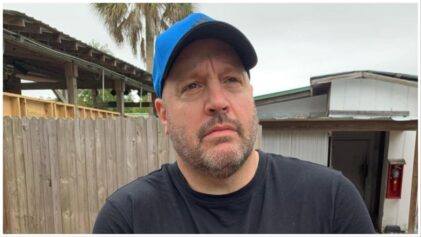
Black Twitter has become an online mecca of comedic memes driven by pop culture references, the creative hub that produces a unique wave of slang and lingo and a digital town hall where members of the community come together to voice their frustrations with a nation shrouded in racism.
We have long discussed the important social implications and the sheer influence of Black Twitter, but in the wake of the tragic killings of unarmed Black citizens like Michael Brown and Eric Garner the virtual community revealed just how powerful it really was.
Black Twitter’s ability to step forward as a watchdog and a virtual journalist was put to the ultimate test—and it certainly delivered.
According to mainstream media, the aftermath of Brown’s death involved nothing more than angry looters, violent protesters and mass destruction.
Protesters were labeled collectively as “rioters” and the Ferguson police were painted to be a small force just trying to do its best to maintain peace in the community.
It’s a narrative that many people believed.
“I was so angry when I looked at the news. It really just irked me,” said Esther Gordon, a 59-year-old Georgia native who consumes much of her news through television newscasts. “I really thought—it just seemed like there was this town full of people who just wanted to tear everything apart and you wonder, ‘What good does that do?’ “
It wasn’t until she caught a glimpse of what the mainstream media outlets didn’t portray that Gordon realized just how biased much of the news coverage was.
“I saw the pictures on the Twitter and then these videos and I couldn’t believe it,” she added. “It was like the news was just blatantly lying…it’s like technically they didn’t lie but they kind of did.”
Images of police responding to protesters with military style weapons and armored vehicles swept digital publications.
Twitter feeds were filled with links to raw video of police firing tear gas at protesters and taking down many peaceful citizens with rubber bullets.
The digital community helped circulate video of two journalists prior to their arrest in a McDonald’s a few miles down the street from where protests were happening in Ferguson. With the help of Black Twitter the nation was able to count for themselves how many times Garner told officers he couldn’t breathe after being placed in a chokehold by NYPD officer Daniel Pantaleo.
As one would imagine, the land of two countries also presented two different narratives every time an officer killed a Black citizen.
A New Era of Hashtag Activism
Many discussions about Black Twitter often include one key criticism—what has been deemed hashtag activism. It’s the idea that the new generation only knows how to tweet about problems but has no idea how to go about fixing them or how to mobilize collectively in order to create change.

Rather than keeping public outrage contained in 140 characters or less, the community put its ability to create nationally trending topics to use. Suddenly, the hashtags were not just about generating a conversation; they were about policy changes and organized protests.
#BlackLivesMatter, #HandsUpDontShoot, #ICantBreathe and #ItsBiggerThanYou were only a few of the hashtags used to bring hundreds, and sometimes thousands, of people together to stand in solidarity with Black citizens across the globe who were still suffering at the hands of their oppressors. For the first time, it seemed, Black Twitter was given a real-life identity—Black Twitter went from filling timelines to filling the streets.
What made this so powerful was the amount of reach that the social media vehicle gave to protesters. There used to be a time when one individual’s attempt to gather 1,000 strangers together for one cause would be an extremely complicated and costly task.
But with the help of a simple “#” and thousands of retweets, protests in honor of Brown, Garner, Tamir Rice and more grew like wildfire.
Even more importantly, images of these protests from across the nation were then shared on social media and delivered a powerful blow to mainstream media’s narrative that all protesters were actually just rioters.
Following the chaos that swept Ferguson, there was a stunning amount of focus on violent protests, but those who were logged in and online saw that the majority of the protests didn’t follow the same violent model.
The sub community also works triple time as an investigator and prosecutor in its own right. While this prosecution doesn’t posses the ability to indict, it always held the ability to condemn and it used this power very well.
A Community Craving Answers
The same community that got a book deal snatched from under a juror’s feet in the George Zimmerman trial and forced the promoter behind a Zimmerman boxing match against rapper DMX to cancel the fight, started to use its powers to get answers.
At the very least, they brought attention to the real questions that certainly needed answers.
When 12-year-old Tamir Rice, the boy from Cleveland who was fatally shot by officer Timothy Loehmann, was slain for holding a toy gun, mainstream outlets were quick to focus on the fact that the toy gun had its orange safety indicator removed.

The officer also insisted that he asked Rice to put the toy away at least three times before he fired.
Surveillance footage of the incident, however, allowed Black Twitter to fire back in full force.
Users immediately pointed out the fact that the officer shot at Rice seconds after arriving on the scene.
“The officer started bussin [sic] as soon as his door opened,” one user tweeted before addding “How did u ask him to put the toy down 3x in 3 secs.”
Another user wrote, “We can see that this story doesn’t add up.”
Along with the tweet they shared a screenshot of a headline defending officer Loehmann for firing at the young boy.
Other tweets asked why the officers didn’t administer any type of aid to the boy after they shot him and others demanded to know what kind of training the officers had.
“Call it what you want, but it’s racism and we’re going to get rid of it.”
They were the types of questions that helped remind the nation that the conversation was about more than just racial profiling.
Instead of attacking one large complex system of racism, Black Twitter was unraveling the layers of a flawed justice system one by one.

“So this is kind of our second time at this, right,” Ashton Johnson, a heavy social media user with over 5,000 followers said. “The first time we had a broad message: Stop with the racism. More or less that was it.”
Johnson explained that the social media community learned from its past mistakes and figured out how to properly utilize its digital presence.
“We couldn’t come at these people with a broad claim of racism so we broke it down,” she added. “Played their game a little like, ‘Oh okay you’re not racist but you are doing this, this, this and that.’ Ultimately, what they’ve been doing is racist—A, B, C it was all racist. But being racist is easy to deny. Peel it apart and you have all these things they can’t deny anymore.”
Johnson said nobody is willing to admit to being racist but when you fess up to implementing policies that are targeting Black people or painting Black victims in a negative light, you have still admitted to your racial bias.
“When we break it down these people are like, ‘Oh yeah. I did do that but so what?’ So….that’s racist,” Johnson continued. “Call it what you want, but it’s racism and we’re going to get rid of it.”
Many people also started taking more direct approaches.
Users began tweeting media organizations directly and slamming them for not discussing these issues and it wasn’t long before some outlets were forced to give under the pressure of Black Twitter.
In the past, Black Twitter had already proven it had the ability to contribute to a greater narrative and garner discussions about important causes.
The last few months have proven that the online community is even more powerful than many gave it credit for.
Taking Control of The Narrative
Instead of just allowing the tweeters to contribute to the national discussion, it has emerged as a way for them to take control of the narrative.

Mainstream media was not allowed to control how the community viewed Ferguson in the midst of chaos and it couldn’t spoon feed questionable details about the killing of a 12-year-old boy to the masses.
Claims that a New York officer didn’t actually put Garner in a chokehold fell on deaf ears because everyone’s eyes had already caught sight of the video with officer Pantaleo’s arm wrapped around Garner’s neck.
The voice of those who were frustrated and tired of seeing Black people killed at the hands of officers were allowed to upgrade from a soap box to a national stage. It became incredibly difficult to sweep the truth under the rug.
In the past, many admitted and wrote about the fact that Black Twitter was important but today, in actuality, the social media machine is essential to generating change in the wake of national tragedies.



